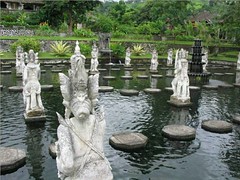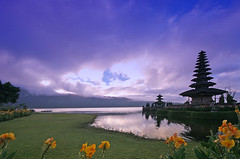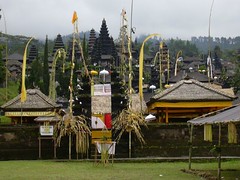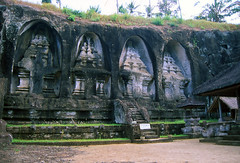Tirtagangga
From here there are a number of excellent treks through the surrounding countryside. One of the most spectacular begins to the north in the village of Tanaharon, quite high on the slopes of Mt Agung. One may reach it on foot or by car. To get there, follow the main road north from Tirtagangga in the direction of Singaraja for several kilometers, then turn left at Abang and follow a small climbing road up to the end. From here one may continue on foot, enjoying the broad panoramas in all directions and the thick, tree-fern vegetation. There is no short-cut back to Tirtagangga, and it is best not to get too far off the main path, as the ravines are quite steep and dangerous.
Another, less taxing trek begins in Ababi, just 2 km north of Tirtagangga on the main road. Turn left in this village and follow the road through Tanah Lengis to Budakling. On foot one can also reach this road by climbing the low hill behind the Tirtagangga spring.
Ababi is an old-fashioned village, and in the fourth Balinese month (around October) a major ritual is held in the village temple an agricultural ceremony marking the end of the dry season. In Tanah Lengis, which closely linked to Ababi, are several unusual music clubs. One is an angk1ung orchestra and the other is a so-called cekepung group.
Cekepung is a form of music known only in Karangasem and on Lombok, from where it originates. It is performed by a group of men. The leader begins by singing a text in Sasak (the language of Lombok); this is then paraphrased by another man in Balinese. After a while the other men join in, and perform a very rhythmic, interlocking song without words - imitating the interplay, rhythm and punctuation of a gamelan orchestra with their voices. Villagers drink palm-wine during and in between the singing. Both groups perform commercially, and will sometimes play for visitors in Tirtagangga.
One enters Budakling just after crossing a broad river, which is almost completely dry during the dry season. This village is well known for its Buddhist brahman priests, of whom there are only a dozen or so left in Bali (whereas their Sivaite colleagues number the hundreds). It is also a famous center for gold and silver smiting. Here are produced jewelry pieces of very high quality, which are occasionally offered for sale in Tirtagangga. It is possible to obtain or order pieces in the village, and Budakling also has several ironsmiths who produce household and agriculture tools.
To go back to Tirtagangga. from here, turn left at the first crossroads in Budakling and ask for Padangkerta, a few km south on main Amlapura-Tirtagangga road. For a longer trip, continue on to the important market village of Bebandem. Entering from this direction, the traveler encounters ironsmiths by the side of the road, which usually work in the mornings on market day (every three days), producing cheap knives keris daggers and cock fighting spurs. There is also an important cattle market here, and once back on the main road one has the choice of going back toward Tirtagangga, south to Candi Dasa, east to Amlapura or west to Besakih and Rendang.
A walk due east from Tirtagangga through the rice fields brings you to Pura Lempuyang, one of the Sad Kahyangan or six main temples of the whole of Bali, perched at the summit of Mt Lempuyang (1058 in). Pass the villages of Kuhum and Tihingtali and continue on to Basangalas. From here, it is a strenuous climb up to the temple. Basangalas can also be reached by car from a turn-off to the north of Tirtagangga at Abang.
A large temple festival takes place at Lempuyang every 210 days on Thursday of the week Dungulan. Ten days later, on Sunday of the week Kuningan, there are festivals in the temples of origin (pura puseh) in many villages around Basangalas, including Lempuyang. These feature fine rejang dances by the unmarried girls of the village accompanied by various orchestras.
Refreshing pools at Tirtagangga
The cool, spring-fed pools at Tirtagangga which literally means "Ganges Water" and refers to the sacred river of the Hindus - are located some 15 km northwest of Amlapura along the main road toward Singaraja. A dip in the pools is deliciously refreshing after a long drive, and they are surrounded by a captivating landscape of terraced rice fields. The village itself is small and quiet, and is a good place to pause and rest for several hours or even several days - to take advantage of the many delightful walks from here.
One can stay overnight inside the pool complex itself, known officially as Tirta Ayu ("lovely waters"), where a son of the last king of Karangasem operates a small home stay. Another exciting possibility is to stay in a small lodging on a nearby hill with a view over the famous Tirtagangga rice terraces.
Another, less taxing trek begins in Ababi, just 2 km north of Tirtagangga on the main road. Turn left in this village and follow the road through Tanah Lengis to Budakling. On foot one can also reach this road by climbing the low hill behind the Tirtagangga spring.
Ababi is an old-fashioned village, and in the fourth Balinese month (around October) a major ritual is held in the village temple an agricultural ceremony marking the end of the dry season. In Tanah Lengis, which closely linked to Ababi, are several unusual music clubs. One is an angk1ung orchestra and the other is a so-called cekepung group.
Cekepung is a form of music known only in Karangasem and on Lombok, from where it originates. It is performed by a group of men. The leader begins by singing a text in Sasak (the language of Lombok); this is then paraphrased by another man in Balinese. After a while the other men join in, and perform a very rhythmic, interlocking song without words - imitating the interplay, rhythm and punctuation of a gamelan orchestra with their voices. Villagers drink palm-wine during and in between the singing. Both groups perform commercially, and will sometimes play for visitors in Tirtagangga.
One enters Budakling just after crossing a broad river, which is almost completely dry during the dry season. This village is well known for its Buddhist brahman priests, of whom there are only a dozen or so left in Bali (whereas their Sivaite colleagues number the hundreds). It is also a famous center for gold and silver smiting. Here are produced jewelry pieces of very high quality, which are occasionally offered for sale in Tirtagangga. It is possible to obtain or order pieces in the village, and Budakling also has several ironsmiths who produce household and agriculture tools.
To go back to Tirtagangga. from here, turn left at the first crossroads in Budakling and ask for Padangkerta, a few km south on main Amlapura-Tirtagangga road. For a longer trip, continue on to the important market village of Bebandem. Entering from this direction, the traveler encounters ironsmiths by the side of the road, which usually work in the mornings on market day (every three days), producing cheap knives keris daggers and cock fighting spurs. There is also an important cattle market here, and once back on the main road one has the choice of going back toward Tirtagangga, south to Candi Dasa, east to Amlapura or west to Besakih and Rendang.
A walk due east from Tirtagangga through the rice fields brings you to Pura Lempuyang, one of the Sad Kahyangan or six main temples of the whole of Bali, perched at the summit of Mt Lempuyang (1058 in). Pass the villages of Kuhum and Tihingtali and continue on to Basangalas. From here, it is a strenuous climb up to the temple. Basangalas can also be reached by car from a turn-off to the north of Tirtagangga at Abang.
A large temple festival takes place at Lempuyang every 210 days on Thursday of the week Dungulan. Ten days later, on Sunday of the week Kuningan, there are festivals in the temples of origin (pura puseh) in many villages around Basangalas, including Lempuyang. These feature fine rejang dances by the unmarried girls of the village accompanied by various orchestras.
Refreshing pools at Tirtagangga
The cool, spring-fed pools at Tirtagangga which literally means "Ganges Water" and refers to the sacred river of the Hindus - are located some 15 km northwest of Amlapura along the main road toward Singaraja. A dip in the pools is deliciously refreshing after a long drive, and they are surrounded by a captivating landscape of terraced rice fields. The village itself is small and quiet, and is a good place to pause and rest for several hours or even several days - to take advantage of the many delightful walks from here.
One can stay overnight inside the pool complex itself, known officially as Tirta Ayu ("lovely waters"), where a son of the last king of Karangasem operates a small home stay. Another exciting possibility is to stay in a small lodging on a nearby hill with a view over the famous Tirtagangga rice terraces.




